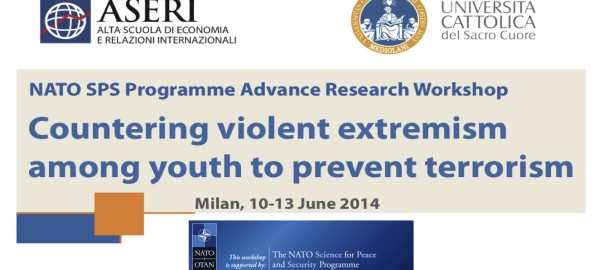Catholic University of Milan in co-operation with the Al-Ahram Center for political and strategic studies (ACPSS) of Cairo origanized the NATO Science for Peace and Security (SPS) Programme Advanced Research Workshop: Countering violent extremism among youthto prevent terrorism. held on 10-13 June 2014 at ASERI in Milan.
Here is the scientific contents summary:
Violent Extremism that can motivate young people to engage in terrorism acts. This phenomenon calls for more effective responses to tackle terrorist organisations’ capacity to recruit young people worldwide. New members are an essential resource for pursuing a political agenda based on violence means.
Protracted political crisis and instability are key drivers for the emergence of violent extremism. Conflicts such as those occurring in MENA countries continue to attract youth from abroad for what they see as a defensive jihad. ‘Foreign Fighters’ and mercenaries combatants that move from one zone of conflict to the other highlights the seriousness of the situation EU countries worry that young returnees from battlefields of the jihad pose a threat to society, something that has already begun to manifest itself.. ‘Foreign Fighters’-related threats need to be addressed more comprehensively with a closer political level dialogue since they affect other departure, transit and receiving countries.
There is a risk of growing Islamophobia in some West- and Central European countries under the impact of real threats as well as ill-considered CVE policies. To counter risks associated with counterproductive counterterrorism tailored counter-narratives reflecting realities of multiculturalism ought to be considered.. Government might not be the best social carrier of persuasive counter-narratives to the jihadist narrative of Al-Qaeda, ISIS and affiliated groups. More street credibility can in some cases be found when former extremists and repentant terrorists who have served their sentence can be used as messengers’ to reach the recruiting base of jihadists Narratives strategies should be proactive rather than be merely reacting to ‘wrong’ messages. Anthropologists and historians ought to be involved when formulating counter-narratives to the single narrative of jihadist recruiters in the West. There is a need for on-going evaluation studies as measures against radicalisation are devised and implemented.
Real grievances of populations for which extremists claim to speak ought to be addressed by governments. Concretely, with regard to the Syrian crisis where young people from more than 80 countries have become involved, partly driven by a humanitarian impulse and partly mislead about the nature of the conflict, new out of the box policies need to be developed. There is also a need to place more emphasis on planning post-conflict reconciliation measures when the endgame approaches. No time should be lost to prepare for post-conflict policies.
There are many drivers for political extremism and terrorism State failure, corruption, illegitimate rule, perceived injustices associated rightly or wrongly with Western policies or past military interventions must be considered as incubators of terrorism. Addressing such issues requires transitional justice programs and state-building measures as well as reconciliation efforts. Importantly, proper security has to be re-established in order to induce people to return to their homes and give them confidence for the future. Civil society organisations must be strengthened so that self-help and development stimuli from outside can be combined for national reconstruction.
Ideally, civil society organisations should be able to function independently from governments since this will provide them with greater legitimacy and credibility and allow them to act constructively, offering an alternative to the false promises of extremists who can see only violent solutions to transform blocked societies.
Among the measures to be taken for social reconstruction figures training for police officers on human rights. This will give them a solid basis for engaging in community-policing activities. Military personnel also needs to be instructed in this way and has to be informed about local customs and traditions (e.g. Sharia law) before being deployed in peace-keeping and peace-enforcement interventions.
Counter-radicalization efforts are sometimes needed on both sides of a conflict dyad as polarization has widened the gap separating members of the community. The planning and implementation of CVE actions ought therefore not only look in one direction. Analogies between practices of organized crime and terrorist organizations need to be explored; what works against youth gang formation might also work against recruitment for violent extremism.
Young people exploring their own identity and their role in society need guidance from families, schools, mosques and civil society organisation so that they do not fall prey to the lure of extremist propaganda. A certain degree of radicalism which is widespread among rebellious young people should not be confused with violent extremism that relies on on- and off-line recruitment efforts by religious and political entrepreneurs who exploit the idealism of young people and instrumentalise it for their ideological purposes. Hence, recruitment has to be targeted rather than radicalism per se..
The internet should be used for developing robust and credible communication strategies to prevent vulnerable youth from choosing the path to terrorism. An array of tools running on the web which enjoy popularity among youth can provide the building blocks to realize communication strategies based on creative and imaginative solutions for drawing the attention of youth. In order to compete against the strong ideological appeal from jihadists penetrating messages have to be developed. An example is the experimental comic striplike character of ‘Abdullah X’ (with his ‘mind of a scholar and heart of a warrior’) who speaks the language of radicalised youth. Another example for persuasive strategies was the T-shirt campaign of a German NGO that promoted the exit of right-wing youth from their extremist organizations. Next to counter-narratives, there also ought to be more consideration given to ‘alternative narratives’ that emphasize our own virtues and dreams

